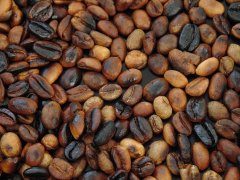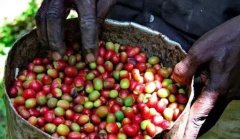[picking beans] picking beans is a very important move.

For professional baristas, please follow the coffee workshop (Wechat official account cafe_style)
The delicacy of a cup of coffee will be greatly reduced once mixed with defective beans, no matter how fresh and expensive the beans are, it will be uncomfortable and destroy the flavor of the whole pot of coffee beans.
And most of the coffee that makes people feel palpitation and discomfort is usually caused by defective beans (such as mold infection, worm-eaten beans, sour beans), which emit biotoxins and have an impact on health.
We adhere to and strictly screen raw beans, the process:
1. After the whole bag of raw beans is purchased, the whole batch of raw beans are selected for the first time, such as mold infection, worm-eaten beans, sour beans and sift out the powder layer of bean skin.
two。 A small amount of sub-packaging, in order to avoid exposed beans, raw beans spread to each other, the whole bag to pick up a small amount of sub-storage.
3. After the raw beans enter the roasting mature beans, pick them again to find out some problems that are not easy to detect before baking, so as to achieve the quality of fine coffee.
~ this is my baking persistence.
[common basic defective raw beans]
* moth-eaten beans
Insects enter and lay eggs when the coffee fruit is ripe, and the larvae eat the coffee fruit and grow, leaving traces of moth on the surface of the beans. usually the holes left by these larvae are connected, there are insect-eroded holes in one end of the beans, and the other is connected to him on the other. Moth-eaten beans can cause the coffee liquid to be cloudy and sometimes produce a strange smell.
* sour beans
Generally, sour beans are black or dark inside. Once sour beans are cut or scratched to cause damage, they will release a sour taste like vinegar. When baking, a sour bean can destroy a pot of beans. The reason for the emergence of sour beans is generally contaminated by microorganisms in the process of harvest or treatment. Especially when picking ripe fruits and falling on the ground, they are contaminated in the washing process, and the fruits growing on trees are overfermented due to the influence of wet climate, which is especially easy to produce sour beans. Sour beans mixed with coffee will produce a rotten smell.
* Shell beans
Shell beans are malformed beans with poor growth. It consists of two parts, the shell and the heart, which may be together or separate. the shell is like a shell and the inner part is like a cone or cylinder. Shell beans can cause uneven baking and are easy to catch fire when deep-baked.
* Black beans
Excessive fermentation of coffee beans and microorganisms can turn beans black. black beans have all-black beans and local black beans. Black beans generally mature early and fall to the ground, and turn black after long-term contact with the ground, which can be easily picked out through the preferred steps. Coffee mixed with black beans is muddy and has a rotten taste.
* damaged beans
In the process of peeling the raw coffee beans, the coffee beans come into contact with the machine leaves, and the damaged beans are formed because of the damage caused by mechanical cutting and other actions.
* unripe beans
Beans harvested before they are ripe are generally pale and yellowish green in the skin and silver skin of the unripe beans. The silver skins cling to the raw beans. The immature beans are usually smaller than the mature coffee beans, with inward curling surfaces, and the edges of the beans are not smooth enough. Unripe beans have a fishy and disgusting taste.
Important Notice :
前街咖啡 FrontStreet Coffee has moved to new addredd:
FrontStreet Coffee Address: 315,Donghua East Road,GuangZhou
Tel:020 38364473
- Prev

Coffee roasting experiment: taxiing experiment of non-embroidered steel inner pot of local cannon and cast iron inner pot of business machine
For the exchange of professional baristas, please pay attention to the coffee workshop (Wechat official account cafe_style) [the storage temperature of the unembroidered steel inner pot of the local cannon is different from that of the cast iron inner pot of the business machine] so the temperature immediately drops as soon as the fire is turned off. Although the beans themselves can still bake themselves, there is a difference in temperature. 1. One kilogram machine: the temperature is still rising in a straight line, the taxiing time is about 30 seconds, and some beans are not careful.
- Next

Birthplace of Coffee | know the raw beans of Ethiopia
For professional baristas, please follow the coffee workshop (Wechat official account cafe_style) Ethiopia is the birthplace of Arabica coffee. According to research, wild Arabica grows in the forests of the Kaffa region of Ethiopia. Ethiopians have been drinking coffee longer than anyone else. Coffee is an essential drink in the daily life of the people, and about 50% of the output is mentioned.
Related
- Beginners will see the "Coffee pull flower" guide!
- What is the difference between ice blog purified milk and ordinary milk coffee?
- Why is the Philippines the largest producer of crops in Liberia?
- For coffee extraction, should the fine powder be retained?
- How does extracted espresso fill pressed powder? How much strength does it take to press the powder?
- How to make jasmine cold extract coffee? Is the jasmine + latte good?
- Will this little toy really make the coffee taste better? How does Lily Drip affect coffee extraction?
- Will the action of slapping the filter cup also affect coffee extraction?
- What's the difference between powder-to-water ratio and powder-to-liquid ratio?
- What is the Ethiopian local species? What does it have to do with Heirloom native species?

